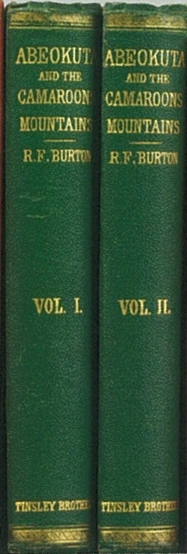
 Abeokuta and the Camaroons Mountains.
An Exploration.
Abeokuta and the Camaroons Mountains.
An Exploration.
First edition of 1863 in two volumes.
Tinsley Brothers: London.
Volume 1 PDF
Page Images
Volume 2 PDF
Page Images
PREFACE
It is an explorer's duty to record as well as to receive impressions of what appears novel to him. Amongst the English, Robert Bruce and Mungo Park; Adanson and the Abbé Rochon amongst the French; and amongst the Germans, Humboldt, the 'Prince of Travellers,were so mindful of this obligation, that they spent long years in polishing their journals; and they owe at least as much—-if not more-—of their enduring celebrity to their admirable descriptions as to the extent of their discoveries and the accuracy of their observations. Let us follow--however humbly--in their wake without repining. Such, however, is by no means the case with contemporaries: in these days every little leader of an expedition, forgetting that 'scribere est agere,' finds a ready salve for sore vanity by writing as it were under protest, and by assuming the superiority of one who boasts that it is his peculiar province to do—not to write.
But, quorsum hæc tam putida tendunt? Abeokuta--Understone--the present capital of the Egba or Aku race, and without comparison the most important position in the broad lands which we know by the name of Yoruba, is, as might be expected, a 'trita via.' Four volumes upon the subject have been alluded to in the following pages. Two of these are by the weaker sex; and the authoresses, who are not travellers, have produced neat little drawing-room sketches, all couleur de rose; the African as you see him upon the walls of the Royal Academy, now dressed up and musqué, now subjected to the old stock horrors--slave-driving, for instance--which he is made to endure with all the gestures of a Briton: it is, in fact, Ethiopia viewed through European eyes Africa by the 'own artist' of the 'Illustrated News.' The other two are in the missionary-African line; they, of course, run in a well-known groove. Without quoting the old saw, 'semper aliquid novi say ex Africa,' there is still much to say upon the well-worn subject of Abeokuta. And the tale of an unenthusiastic traveller, who tells the truth as far as truth lies in him, cannot fail, even when treating of Yoruba, to convey some novel facts. ...
The Appendices are:1st. A description of the Ambozes, or Camaroons Country, by M. J. Grazilhier, who in 1699 made a voyage to Old Calabar, extracted from Barbot.
2nd. The journal of the late Mr. Merrick, of the Camaroons Mission, who, as far as is known, first attempted to ascend the mountain : it is borrowed from the ' Baptist Missionary Herald.'
3rd. Sir William Hooker's list of the botanical specimens collected upon the Camaroons Mountains by M. Gustav Mann.
4th. Dr. Gray's descriptions of the animals forwarded to the British Museum, at the end of the Camaroons explorations.
5th. Letters, official reports, and memorandum, on the high land of Camaroons, by the late Mr. M'Gregor Laird and the Rev. A. Sakcr ( reprinted from the Blue Book of 1857).
6th. Meteorological observations, by M. Gustav Mann and Selim Aga.
7th. Hypsometrical table.
With the firm expectation of seeing, quamprimum, a sanitarium for the feverish denizens of Lagos, the Oil Rivers, and Fernando Po, established in this region of health and future plenty, and hoping that the public will honour my labours with its approval, I relieve the reader from the tedium of a longer preface.
Fernando Po, 1863.
RICHARD F. BURTON.